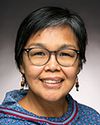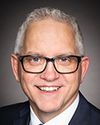Good afternoon. Thank you for the invitation and congratulations, Madam Chair.
It's a pleasure to be here in the nation's capital on the unsurrendered territory of the Anishinabe Algonquin nation to discuss topics that are very important to me.
I come to you from La Ronge, Saskatchewan, located on Treaty No. 6 territory and the home of the Métis people. As a lifelong northerner and the father of two indigenous boys, I hope to bring perspective of the work that is being done and needs to be done in order to improve graduation rates and successful outcomes for northern and indigenous students.
I've had the opportunity to work with the Saskatchewan Ministry of Education for close to seven years. As the education adviser to the deputy minister's office, there are several crucial developments that have improved the educational opportunities for northern and indigenous students. As we work towards educational improvement in the province, our minister, the Honourable Dustin Duncan, and the deputy minister, Donna Johnson, have set priorities to ensure a path of a collaborative journey with indigenous, northern and Métis partners.
In this spirit of collaboration, the Ministry of Education has been working on a new provincial education plan that is inclusive to and cognizant of the students we serve. This plan will serve as the foundation of education in the province until 2030 and includes indigenous knowledge throughout. Indigenous and Métis stakeholders are part of the creation and implementation of this innovative plan. Areas such as student mental health are also pillars of this plan.
There are five important aspects that are critical investments to improve the education of indigenous, Métis and northern students.
The first is strategic investment and resourcing in the early years. As numerous studies have indicated, strategic investments in early childhood development have significant societal and financial gains. As a province, we have invested in family resource centres, KidsFirst North, early childhood intervention programs and child care centres. The Canada-Saskatchewan Canada-Wide Early Learning and Child Care Agreement and the bilateral Canada-Saskatchewan Early Learning and Child Care Agreement are two examples of the collaborative nature of the levels of government coming together to impact kids.
The second is curriculum and instructional supports. In addition to a collaborative and inclusive curriculum model, the Ministry of Education's “Following Their Voices”, the invitational shared services agreement and the learning opportunities program—or the LOP—provide supports, collaboration and funding to improve teacher practice and to engage school divisions and first nations authorities. LOP funding includes science, technology, engineering and mathematics—or STEM—instruction. Saskatchewan mandated treaty curricula in 2007, and it has proven to be extremely important for all students in the province.
The third is infrastructure investment. It is important that northern and first nations communities have access to safe and welcoming schools that are reflective of them within their communities. The Ministry of Education continues to invest in school renovation and replacement, with a strong example being the $30-million elementary school that is currently being built in La Loche. Minister Duncan said, “This new elementary school will be able to serve not only the students and families of La Loche, but also the broader community for generations to come.” The school is set to open in spring 2025 and has been designed with community aspects throughout.
The fourth is teacher recruitment and retention, which continues to be an issue in northern Saskatchewan. The Government of Saskatchewan continues to fund teacher programs such as the Dene teacher education program in La Loche and local regional colleges to provide local teacher education programs. It is well understood that teachers learning in their respective communities have a higher success rate and are more inclined to stay and teach in the communities they call home. When indigenous, northern and Métis students see that their teachers are just like them, this creates an atmosphere of trust, pride and success. The Ministry of Education also works with local school divisions on ways to best support their recruitment and retention plans in both strategic and financial ways.
The fifth is distance learning opportunities. The Government of Saskatchewan is in the process of establishing a new Saskatchewan Distance Learning Corporation, or Sask DLC. The new centralized school will streamline online learning in the province and provide students across the province with equal access to more than 180 online courses for kindergarten to grade 12 students, including more than 120 high-school electives to choose from. The Sask DLC will have a central office in Kenaston, Saskatchewan, with nine additional satellite locations that will help serve every geographic region in the province. In-school online facilitators will assist students with any learning challenges they may experience. It is important to note that the Sask DLC will provide opportunities to students where there may not be a teacher, or there's a teacher shortage within their classroom. This model will help students in remote areas with receiving the best possible education.
As indicated, Saskatchewan is doing innovative and transformative things to make educational standing and opportunities a priority for first nations, indigenous, northern and Métis students. With strong instruction and support, there's significant opportunity to work with first nations and Métis stakeholders to make our collective education system the best it can be for all students.
I'd like to thank the Standing Committee on Indigenous and Northern Affairs for the invitation to speak on ways to improve the educational attainment of our students. I am looking forward to the rest of our time as we engage in this discussion and important topic.
As we would say in northern Saskatchewan, thank you, merci, têniki and mahsi cho.





